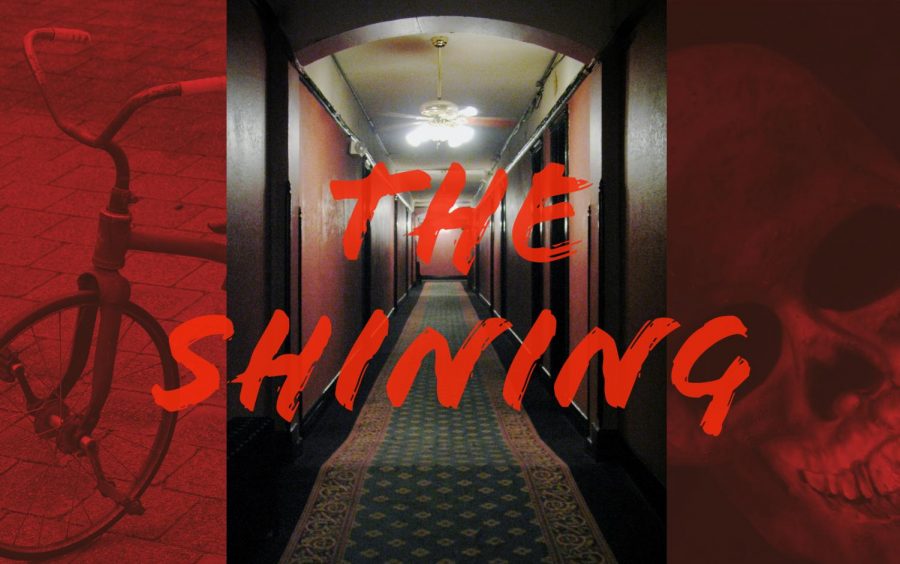Halloween Horror Month: ‘The Shining’
Review
October 5, 2018
Based off the Stephen King novel The Shining, the 1980 movie adaptation has plagued TV screens since its release. The intense psychological thriller delves not so much into jumpscares, but thrives in creating suspense and delaying what the audience knows is inevitable, which gave rise to its consideration as a classic horror movie.
Aside from being a well-known horror film, the tale does have a small sliver of truth to it. When spending a night in the reportedly haunted Stanley Hotel in Estes Park, Colorado, Stephen King learned that he and his wife were the only two guests as the hotel would be closing for the winter the following day. After dreaming of his son running scared through the corridors, he set his mind on writing The Shining.
Both the book and film follow the Torrance family over the course of a winter as they live in solitude at the Overlook Hotel, taking care of the place during the off-season. Jack, an aspiring author, thinks the giant refuge in the Rocky Mountains will be perfect for him to focus on his writing, and insists that loneliness will not not drive him to the same fate as a previous caretaker (who murdered his daughters and wife before killing himself). The isolation, however, proves to be too much as seemingly innocent mood swings turn more and more violent.
Despite the plot circling around Jack’s demise, his son Danny also sees the true horrors of the hotel. From hallways filled with gushing blood to a pale pair of sisters, the youngster’s visions foreshadow what is yet to come. The most haunting effects of the hotel are perceived by Danny, which only heightens the effect of the film. While Jack sees hallucinations of the past and his wife Wendy is left relatively unscathed by visions, Danny, who can’t be more than six, takes in the majority of these horrifying sights. This leaves the audience with nothing to do but watch as his innocence and naivety is slowly stripped away from him as he struggles to comprehend what is going on around him, feeding the ever-growing suspense.
Throughout the film, the real horror comes not from the content of the plot but the anticipation. Any sound made in the empty hotel seems to be magnified, and incessant buzzing often fills the air as Danny or Jack fall prey to visions of the past and what is yet to come, crescendoing into a wave of sound that is almost unbearable. Contrasting from the loud, grating noises, the moments of pure silence in the film provide just as much anticipation. These fleeting moments are usually accompanied with the magnification of a simple sound, like the whirring wheels of Danny’s bike as he entertains himself amongst the empty hallways, the rhythmic pounding of footsteps, even the clacking of keys on Jack’s typewriter are transformed into dread-inducing noises. Since Jack, Wendy, and Danny are the only three residents of the hotel, silence would seem to be pervasive, but insead, the small moments of quiet are omens of something worse yet to come.
Arguably the most impactful aspect of the film is how realistically the entire plot plays out. Aside from the horrifying visions, the thrill of the movie stems mainly from the degradation of Jack’s mental state and the devastation it has on his family. The emptiness of the hotel sets the entire family on edge, and as Jack’s mental state slips from rational to insane, it leaves the audience pondering what exactly they would do in that situation and how they would react.
As with most horror films, the unexpected or unseen often prove to create the scariest moments. Director Stanley Kubrick used this to his advantage, often keeping the subject of the character’s reactions just out of the frame while making it obvious to the audience that something is there. This choice is yet another effective method of increasing the audience’s anticipation of what they know is coming. The second Jack’s boss informs him of what had happened to a previous winter caretaker, it’s evident to the audience that the same fate will come to rest on Jack’s shoulders. From that moment on, it’s a waiting game until he inevitably caves. This makes the shots in which the cause of fear is just barely out of the picture so much more impactful, as each minute watching is spent in fear of Jack losing his last shred of sanity.
The emotional connection forged between the audience and the Torrance family is what elevates this film from others in its genre. It takes a family and pushes them to their limits, illustrating exactly how far a mother would go to save herself and her child, even if it was from someone dear to them, and toys with your heartstrings throughout the entire runtime. While their unconditional love for eachother remains, it calls into question the humanity of each of the characters and what they are willing to do to survive, which is more chilling than any ghost story.
Despite the film’s bad reception at its release, with Stanley Kubrick and Shelley Duvall nominated for Razzie Awards (mock awards for infamously bad performances) as Worst Director and Worst Actress respectively, The Shining has since become a fan-favorite horror movie due to its realistic plot, suspenseful soundtrack, and tendency to milk the moments in which the real horror appears off-screen. The film as a whole is an intense watch, but is definitely worth it if you enjoy psychological thrillers more than supernatural horror films.



